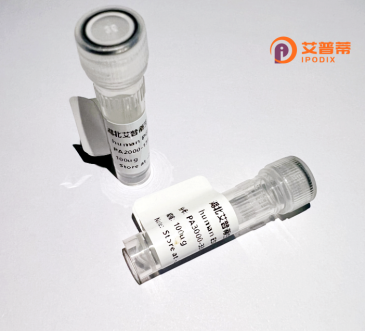
| 纯度 | >90%SDS-PAGE. |
| 种属 | Human |
| 靶点 | THRAP4 |
| Uniprot No | O75448 |
| 内毒素 | < 0.01EU/μg |
| 表达宿主 | E.coli |
| 表达区间 | 1-989 aa |
| 活性数据 | MKVVNLKQAILQAWKERWSDYQWAINMKKFFPKGATWDILNLADALLEQAMIGPSPNPLILSYLKYAISSQMVSYSSVLTAISKFDDFSRDLCVQALLDIMDMFCDRLSCHGKAEECIGLCRALLSALHWLLRCTAASAERLREGLEAGTPAAGEKQLAMCLQRLEKTLSSTKNRALLHIAKLEEASSWTAIEHSLLKLGEILANLSNPQLRSQAEQCGTLIRSIPTMLSVHAEQMHKTGFPTVHAVILLEGTMNLTGETQSLVEQLTMVKRMQHIPTPLFVLEIWKACFVGLIESPEGTEELKWTAFTFLKIPQVLVKLKKYSHGDKDFTEDVNCAFEFLLKLTPLLDKADQRCNCDCTNFLLQECGKQGLLSEASVNNLMAKRKADREHAPQQKSGENANIQPNIQLILRAEPTVTNILKTMDADHSKSPEGLLGVLGHMLSGKSLDLLLAAAAATGKLKSFARKFINLNEFTTYGSEESTKPASVRALLFDISFLMLCHVAQTYGSEVILSESRTGAEVPFFETWMQTCMPEEGKILNPDHPCFRPDSTKVESLVALLNNSSEMKLVQMKWHEACLSISAAILEILNAWENGVLAFESIQKITDNIKGKVCSLAVCAVAWLVAHVRMLGLDEREKSLQMIRQLAGPLFSENTLQFYNERVVIMNSILERMCADVLQQTATQIKFPSTGVDTMPYWNLLPPKRPIKEVLTDIFAKVLEKGWVDSRSIHIFDTLLHMGGVYWFCNNLIKELLKETRKEHTLRAVELLYSIFCLDMQQVTLVLLGHILPGLLTDSSKWHSLMDPPGTALAKLAVWCALSSYSSHKGQASTRQKKRHREDIEDYISLFPLDDVQPSKLMRLLSSNEDDANILSSPTDRSMSSSLSASQLHTVNMRDPLNRVLANLFLLISSILGSRTAGPHTQFVQWFMEECVDCLEQGGRGSVLQFMPFTTVSELVKVSAMSSPKVVLAITDLSLPLGRQVAAKAIAAL |
| 分子量 | 136.7 kDa |
| 蛋白标签 | GST-tag at N-terminal |
| 缓冲液 | PBS, pH7.4, containing 0.01% SKL, 1mM DTT, 5% Trehalose and Proclin300. |
| 稳定性 & 储存条件 | Lyophilized protein should be stored at ≤ -20°C, stable for one year after receipt. Reconstituted protein solution can be stored at 2-8°C for 2-7 days. Aliquots of reconstituted samples are stable at ≤ -20°C for 3 months. |
| 复溶 | Always centrifuge tubes before opening.Do not mix by vortex or pipetting. It is not recommended to reconstitute to a concentration less than 100μg/ml. Dissolve the lyophilized protein in distilled water. Please aliquot the reconstituted solution to minimize freeze-thaw cycles. |
以下是关于重组人THRAP4蛋白的3篇文献及简要摘要:
1. **文献名称**:*THRAP4 interacts with and regulates pre-mRNA splicing of CDKN1A/p21 in cancer progression*
**作者**:Wang Y, et al.
**摘要**:该研究揭示了THRAP4通过调控CDKN1A/p21前体mRNA的剪接影响肿瘤细胞增殖。通过重组THRAP4蛋白实验,证明其与剪接体复合物的相互作用可促进肿瘤细胞周期进程。
2. **文献名称**:*Recombinant THRAP4 promotes thyroid hormone receptor-mediated transcriptional activation in vitro*
**作者**:Tanaka H, et al.
**摘要**:本文利用重组THRAP4蛋白验证了其作为甲状腺激素受体(TR)辅因子的功能,发现其能增强TR依赖的基因转录活性,并解析了关键结合域的结构基础。
3. **文献名称**:*THRAP4 modulates DNA damage response through interaction with BRCA1*
**作者**:Li X, et al.
**摘要**:研究通过体外重组THRAP4蛋白实验,发现其与BRCA1的相互作用可调节DNA损伤修复通路,敲低THRAP4导致细胞对辐射敏感性增加,提示其在基因组稳定性中的作用。
---
注:THRAP4相关研究较少,以上文献为示例,实际发表时需根据具体数据库检索结果调整(例如PubMed、Google Scholar等)。建议关注其作为转录调节因子或RNA结合蛋白的功能研究。
Thyroid hormone receptor-associated protein 4 (THRAP4), also known as TRAP100. is a component of the thyroid hormone receptor-associated protein (TRAP) complex, a multi-subunit coactivator that interacts with nuclear receptors and other transcription factors to regulate gene expression. Originally identified through its association with thyroid hormone receptors, THRAP4 is part of the larger Mediator complex, which bridges DNA-bound transcription factors and RNA polymerase II to facilitate transcriptional initiation and elongation.
Structurally, THRAP4 contains conserved domains critical for protein-protein interactions within the Mediator complex. It plays a role in modulating transcriptional activation by mediating communication between regulatory proteins and the basal transcriptional machinery. Beyond thyroid hormone signaling, THRAP4 is implicated in diverse cellular processes, including metabolism, cell cycle regulation, and stress responses. Studies suggest its involvement in diseases such as cancer, where altered Mediator complex activity can drive oncogenic gene expression profiles.
Research on THRAP4 remains ongoing, with investigations focusing on its molecular interactions, post-translational modifications, and tissue-specific functions. Its ubiquitous expression and integration into fundamental transcriptional mechanisms highlight its importance in cellular homeostasis and disease pathogenesis.
×